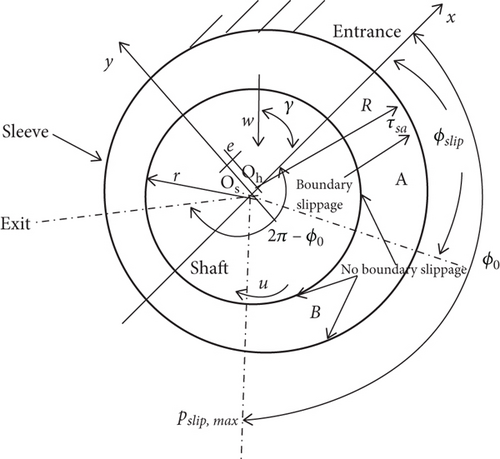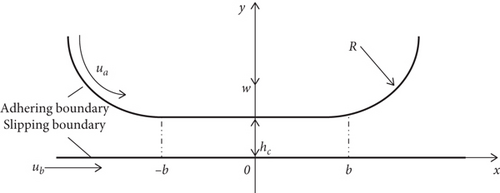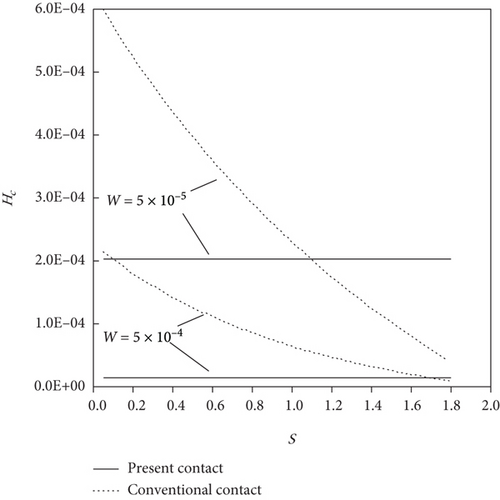Energy-Conserved Hydrodynamic Lubricated Components with Wall Slippage
Abstract
The hydrodynamic thrust slider and journal bearings as well as hydrodynamic lubricated gears with the merit of energy conservation by the wall slippage are reviewed. The principle for designing these hydrodynamic contacts is to artificially set the wall slippage on the stationary surface in the hydrodynamic inlet zone. To design the wall slippage on the moving surface in the hydrodynamic outlet zone can also give additional benefits. The technical merits of these mechanical components are the improved load-carrying capacity and the lowed friction coefficient, i.e., the energy conservation due to the wall slippage. Owing to the designed wall slippage, the carried load of the hydrodynamic step bearing can be increased by 200%~400% while its friction coefficient can be reduced by 50%~85%, and the load-carrying capacity of the hydrodynamic journal bearing can be increased by nearly 100% while at the same time, its friction coefficient can be reduced by more than 60%. For hydrodynamic lubricated gear contacts, by covering ultrahydrophobic or oilphobic coatings on the slower moving surface, the friction coefficient can be approaching to vanishing and the contact load-carrying capacity can be increased very significantly for large slide-roll ratios under medium or heavy loads.
1. Introduction
Energy conservation is a big issue in modern industry. It is mostly related to the frictional power encountered in mechanical transmission. To realize it by reducing friction is of vital value to modern industrial development [1]. Bronshteyn and Kreiner showed that significant energy savings in machines can be obtained by using the energy-efficient lubricants; the performance of which is dependent on the viscosity shear thinning and the viscosity-pressure index [2]. They described that adding the friction modifier into the oils can reduce the friction. Tung and Gao also showed that by adding molybdenum dithiocarbamate (MoDTC) (friction modifier) into the engine oil, the friction and wear on the piston ring had been effectively reduced [3]. The reductions of friction were also realized by adding micrometer-scale or nanometer-scale particles into the lubricating oils [4–7]. These include the biolubricants containing boron nitride nanoparticles [4], the lubricating water containing titanium dioxide nanoparticles [5], the olive oil containing nanoparticles [6], and the avocado and canola oil containing boron nitride nanoparticles [7]. Surface texturing was also found to be an effective way for bettering the hydrodynamic lubrication and reducing the friction in mechanical contacts [8–13]. Surface coatings like diamond-like carbon, titanium nitride, graphite-like carbon, tantalum, and Mo-Se-C coatings have been found to effectively reduce friction in the boundary lubricated contacts [14–17]. The oils with low viscosities have also been used to reduce the friction in hydrodynamic lubrication [18–22]. All the abovementioned methods are the classical popular dints to reduce frictional energy loss in lubricated contacts. In recent decades occurred the new hydrodynamic lubrication technology by using the boundary slippage to improve the load-carrying capacity but reduce the friction coefficient of the hydrodynamic lubricated contacts [23–27]. It revises the moving velocities of the fluid film adjacent to a solid surface and changes the fluid flow rate through the contact. By designing the boundary slippage on specific surfaces such as on the stationary surface in the inlet zone or on the moving surface in the outlet zone or both of them, the performance of a hydrodynamic lubrication including the friction reduction can indeed be very effectively improved.
Hydrodynamic lubricated bearings are the important apparatus to support the load and reduce the friction coefficient in rotating machinery. Their energy conservation is a critical subject both in the research and in the production development. The classical method for reducing the friction coefficient and improving the energy efficiency of these bearings is to use the low-viscosity lubricant and the lubricant additives [4–7, 18–22, 28]. However, for the condition of heavy loads and high sliding speeds, the technical benefits of these methods seem very limited. In contrary, the boundary slippage technology is particularly suitable for these operating conditions because of its generated large lubricant film load-carrying capacity.
The wall slippage was found to occur in a hydrodynamic journal bearing long time ago [29, 30]. It was interpreted as the result of the shear stress exceeding the capacity of the adhering layer-fluid interface in a normal hydrodynamic journal bearing and found to pronouncedly reduce the load-carrying capacity of the bearing [29–31]. On the other hand, the friction coefficient of the bearing is significantly increased [31, 32]. Thus, the interfacial slippage in a normal hydrodynamic bearing made of steel, which is oilphilic, deteriorates the overall performance of the bearing.
The wall slippage was found to very easily occur in micro-/nanofluidics such as carbon nanotubes, which are hydrophobic [33–37]. With the reduction of the nanopore radius, the wall slippage more easily occurs [38]. By using the interfacial limiting shear strength model, Wang and Zhang satisfactorily explained this phenomenon [39]. The wall slippage can largely increase the water flow rate through carbon nanotubes [5–9]. In hydrophilic nanopores, the wall slippage was not detected, and the water flow rate through the nanopores is significantly reduced. These indicate that the wall surface property of a nanopore, which is hydrophobic or hydrophilic, can change the liquid flow rate in the nanopore. This indeed provides a strong indication for designing the hydrodynamic bearing by applying the wall slippage. Bronshteyn and Kreiner and Tung and Gao [2, 3] actually noticed the influence of the surface property on the carried load of a hydrodynamic journal bearing.
By using the slip length model, Salant and Fortier [40, 41] numerically showed that the wall slippage on the stationary surface in the bearing inlet zone can significantly increase the hydrodynamic pressure and carried load of a three-dimensional hydrodynamic journal bearing. The mechanism of this bearing performance improvement is that the flow rate into the bearing inlet zone is increased due to the occurring wall slippage, and for maintaining the flow continuity, the magnitudes of the pressure gradients as well as the pressures in the bearing must be increased. This also provides the indication that the wall slippage occurring on the moving surface in the bearing outlet zone can also pronouncedly increase the pressures and carried load of a hydrodynamic bearing, as it follows the same principle by reducing the flow rate out of the bearing outlet zone. The study by Zhang [42] on a hydrodynamic step bearing proves this wall slippage effect.
The wall slippage appears to be a promising technical dint for designing the energy-conserved hydrodynamic lubrication in the condition of heavy loads and high sliding speeds. The present paper reviews the impressive researches in recent years on hydrodynamic lubrication by applying the wall slippage to improve the bearing performance. This work can help to elucidate some critical points in the wall slippage, summarize the vital design principles for the bearings by applying the wall slippage, and give the direction in the future research in this area.
2. The Wall Slippage Model
In designing the hydrodynamic bearing, the hydrophobic or oilphobic coating needs to be covered on the stationary surface in the bearing inlet zone so that the slippage can very easily occur on this coating. In this case, the slippage occurs on the adsorbed boundary layer-bearing surface interface, not on the adsorbed boundary layer-fluid interface. If the bearing surface separation is no less than one hundred times of the thickness of the adsorbed boundary layer, the adsorbed boundary layer can be ignored, and the wall slippage can be considered as occurring on the fluid-bearing surface interface [45]. This is usually the case for the hydrodynamic bearing with the designed artificial wall slippage.
In a thrust slider bearing or a journal bearing, the hydrodynamic pressures are not so high so that τs can be considered as independent on the pressure. This is also the case in the inlet zone of a hydrodynamic line contact. Thus in the theoretical research, it should be taken that τs = constant.
3. Hydrodynamic Bearings with the Designed Wall Slippage
3.1. Hydrodynamic Step Bearing

Here, u is the sliding speed; η is the fluid bulk viscosity; τsa is the shear strength of the fluid-stationary surface interface in the inlet zone; τsa,A is the shear strength of the fluid-stationary surface interface in the outlet zone; τsb is the shear strength of the fluid-moving surface interface; ha and hb are the surface separations in the inlet and outlet zones, respectively; and l1 and l2 are the widths of the outlet and inlet zones, respectively. The results show that the increase of the load-carrying capacity of the step bearing by the designed wall slippage in Figure 1 can reach 200%~400%, while the reduction of the friction coefficient of the bearing by the wall slippage can be 50%~85% [42]. For the same load, by using the wall slippage, the frictional heating power in the bearing can also be reduced by 50%~85%. The energy conservation of the step bearing in Figure 1 is thus very obvious. Equations (2)–(5) show that the energy-conserved bearing in Figure 1 can be realized in the condition of high sliding speeds and heavy loads. For achieving the most pronounced technical effect of the wall slippage, the value of rh may be as small as below 1.1 [42]. λτ must be less than unity. Both the reductions of λτ and τsa strengthen the beneficial effect of the wall slippage. The stationary surface in the inlet zone should at best be the most hydrophobic or oilphobic. It can be realized by covering the most hydrophobic or oilphobic coating on the stationary surface in the inlet zone. Developing the ultrahydrophobic or oilphobic materials is of great importance to the energy conservation in the bearing, and it should be put as an important research task in the following time. Both the stationary surface in the outlet zone and the whole moving surface should be hydrophilic or oilphilic.
3.2. Hydrodynamic Journal Bearing

3.3. Hydrodynamic Line Contact


4. Surface Coatings for Setting the Wall Slippage
Preventing or designing the wall slippage on specific surfaces in the hydrodynamic lubricated area relies on the use of the hydro-/oilphilic coatings or the hydro-/oilphobic coatings. The more hydro-/oilphobic the covered surface coating, the more pronounced the wall slippage, and the more significant the improvement of the performance of hydrodynamic lubrication. In contrary, the more hydro-/oilphilic the surface coating, the more reliable the prevention of the wall slippage, which is also required in the design of hydrodynamic lubrication with wall slippage. Besides the well-known hydrophobic materials such as polytetrafluoroethylene (PTFE), carbon, and grapheme, in recent decades, we noticed some impressive super hydro-/oilphobic coatings being used for enhancing the wall slippage such as octadecyltrichlorosilane [46], n-alkyl monolayers [46], silane [47], polydopamine coating [48], and fluoroalkylsilanes [49]. The hydro-/oilphilic materials like silica, silicon nitride, silicon carbonized, and γ alumina as well as steel can be used to prevent the wall slippage in a hydrodynamic lubrication. In the future, ultrahydro-/oilphobic coatings and ultrahydro-/oilphilic coatings should be the development directions for manufacturing reliable hydrodynamic lubricated contacts with a good performance improved by the wall slippage.
5. Conclusions
Energy-conserved hydrodynamic thrust slider and journal bearings as well as energy-conserved hydrodynamic lubricated gears by applying the wall slippage are reviewed. Typically, the wall slippage is designed on the stationary or slower moving surface in the hydrodynamic inlet zone. The wall slippage on the moving surface in the hydrodynamic outlet zone can give additional beneficial effects. By the inlet wall slippage, the flow rate into the hydrodynamic contact is increased, or by the outlet wall slippage, the flow rate out of the hydrodynamic contact is reduced. For maintaining the flow continuity, the magnitudes of the pressure gradients as well as the hydrodynamic pressures must be increased in the whole hydrodynamic contact. Thus, the carried loads of the bearing or the gear contact are correspondingly increased. On the other hand, the wall slippage effect reduces the friction coefficient of the hydrodynamic contact. The designed bearing or gear contact with the wall slippage is therefore energy-conserved. Different from the classical energy conservation method such as using low-viscosity lubricants or lubricant additives, which are not very suitable for high speeds and heavy loads, the present mentioned energy-conserved bearings or gear contacts are realizable particularly for high sliding speeds and heavy loads.
The main technical issue and the future research task are to develop highly or ultrahydrophobic or oilphobic coatings which can be covered on the steel bearing or gear surfaces. In recent years, a few of such coatings have been developed, but their applications are still not seen. Besides these, the design principles of these bearings or gear contacts need to be further complemented by considering more realistic factors such as the thermal and surface roughness effects.
Conflicts of Interest
The authors declare that there is no conflict of interest with this research.
Open Research
Data Availability
The data reported in this paper will be available from the corresponding author with reasonable request.




